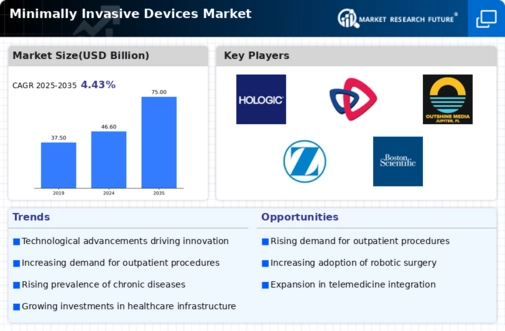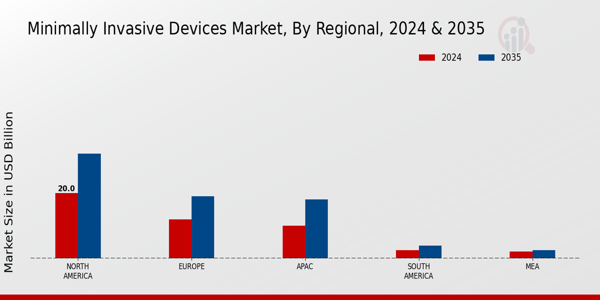Aging Population
The Global Minimally Invasive Devices Market Industry is also influenced by the aging population, which is more susceptible to various health issues requiring surgical intervention. As individuals age, the likelihood of developing conditions that necessitate surgery increases, thereby driving demand for minimally invasive procedures. The demographic shift towards an older population is evident globally, with projections indicating that by 2035, a significant portion of the population will be over 65 years old. This demographic trend is likely to propel the market forward, as healthcare systems adapt to the needs of an aging society, emphasizing the importance of minimally invasive options.
Cost-Effectiveness
Cost-effectiveness is a crucial driver in the Global Minimally Invasive Devices Market Industry, as healthcare providers seek to optimize resources while delivering quality care. Minimally invasive procedures often result in shorter hospital stays and quicker recovery times, which can lead to reduced overall healthcare costs. For instance, studies indicate that hospitals can save substantial amounts by adopting these techniques, as they minimize the need for extended post-operative care. This financial incentive encourages healthcare systems worldwide to invest in minimally invasive technologies, further contributing to the market's anticipated growth, with a projected CAGR of 4.43% from 2025 to 2035.
Market Growth Projections
The Global Minimally Invasive Devices Market Industry is expected to experience substantial growth in the coming years. Projections indicate that the market will reach 46.6 USD Billion by 2024 and is anticipated to expand to 75 USD Billion by 2035. This growth trajectory suggests a compound annual growth rate (CAGR) of 4.43% from 2025 to 2035. Such figures reflect the increasing adoption of minimally invasive techniques across various medical specialties, driven by technological advancements and changing patient demographics. The market's expansion is likely to be supported by ongoing innovations and the rising demand for efficient healthcare solutions.
Technological Advancements
The Global Minimally Invasive Devices Market Industry is witnessing rapid technological advancements that enhance surgical precision and patient outcomes. Innovations such as robotic-assisted surgery and advanced imaging techniques are becoming increasingly prevalent. For instance, the integration of augmented reality in surgical procedures allows surgeons to visualize complex anatomy in real-time, thereby improving accuracy. These advancements not only reduce recovery times but also minimize complications, making procedures safer for patients. As a result, the market is projected to reach 46.6 USD Billion in 2024, reflecting the growing demand for cutting-edge surgical solutions.
Increased Patient Awareness
Increased patient awareness regarding the benefits of minimally invasive procedures is a notable driver in the Global Minimally Invasive Devices Market Industry. Patients are becoming more informed about their treatment options, often preferring procedures that promise quicker recovery and less pain. This shift in patient preferences is prompting healthcare providers to adopt minimally invasive techniques more widely. Educational campaigns and access to information through digital platforms are empowering patients to make informed decisions about their healthcare. Consequently, this trend is likely to sustain the growth of the market, as more individuals seek out less invasive surgical alternatives.
Rising Prevalence of Chronic Diseases
The Global Minimally Invasive Devices Market Industry is significantly driven by the rising prevalence of chronic diseases such as cardiovascular disorders, diabetes, and obesity. These conditions often necessitate surgical interventions, which increasingly favor minimally invasive techniques due to their associated benefits. According to health statistics, the incidence of chronic diseases is on the rise globally, leading to a higher demand for effective treatment options. This trend is expected to contribute to the market's growth, with projections indicating a market size of 75 USD Billion by 2035, as healthcare providers seek to adopt less invasive solutions for managing chronic conditions.







